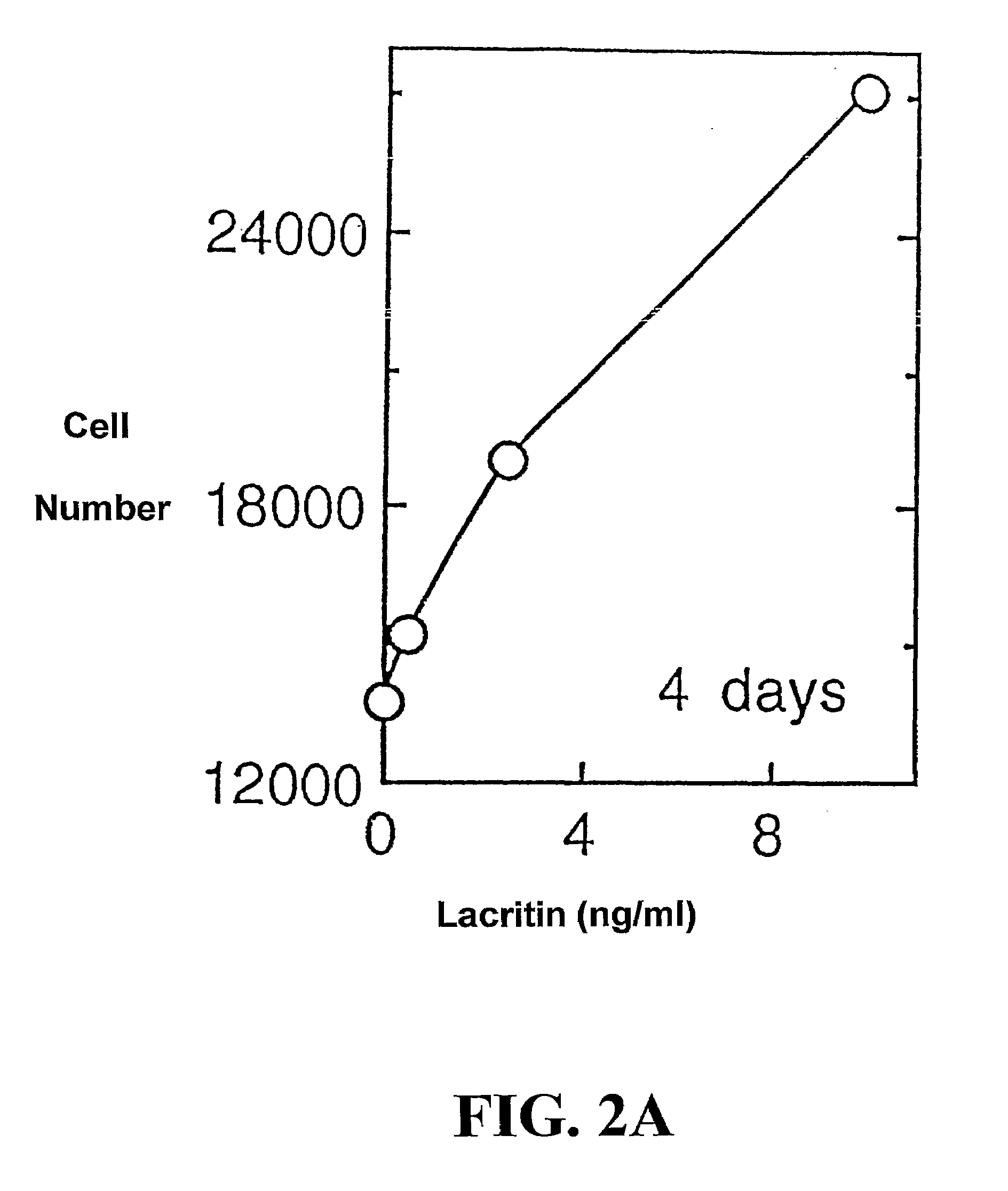Use of lacritin in promoting ocular cell survival
a technology of ocular cell survival and lacritin, which is applied in the field of use of lacritin in can solve the problems of corneal ulceration, corneal ulceration, infection or inflammation, etc., and achieve the effects of preventing and treating corneal infections, and promoting ocular cell survival
- Summary
- Abstract
- Description
- Claims
- Application Information
AI Technical Summary
Benefits of technology
Problems solved by technology
Method used
Image
Examples
example 1
[0196]Isolation of the Lacritin Gene
[0197]cDNA and Genomic Cloning of Lacritin
[0198]Isolation of the lacritin gene has been previously described in detail (see Laurie et al., (U.S. Patent Pub. No. US 2004 / 0081984, published Apr. 29, 2004), which is incorporated by reference in its entirety herein. Duplicate filters containing plaques (5×104 per filter) from each of ten sublibraries of a human lacrimal gland cDNA library were prehybridized at 42° C. for 4 hr in 5× Denhardt's, 6.76×SSC, 10 mM sodium phosphate, 1 mM EDTA, 0.5% SDS and 182 μg / ml salmon sperm DNA, and then hybridized overnight at 42° C. with one of two overlapping 23-mer oligonucleotides [AGCTGGGGCACAGGCACCCGCAC; SEQ ID NO: 11] and [GGGGTTCTGGGGCTGCAGCTGGG; SEQ ID NO: 12] All nucleotide sequences have been submitted to the GenBank / EBI Data Bank with accession numbers af238867 (cDNA) and ay005150 (genomic).
[0199]Northern Analysis
[0200]Human lacrimal and submandibular glands were obtained during autopsy through the Souther...
example 2
[0210]Characterization of Lacritin Expression and Function
[0211]Preparation of Recombinant Lacritin and Anti-Lacritin Antisera
[0212]These reagents were prepared as previously described in detail (see Laurie et al., (U.S. Patent Pub. No. US 2004 / 0081984, published Apr. 29, 2004).
[0213]Cell Function Analysis
[0214]Freshly isolated rat lacrimal acinar cells, and HSG (human salivary gland) ductal and HCE (human corneal epithelial) cell lines were used to study lacritin function. For secretion studies, rat acinar cells were plated serum-free overnight on wells co-coated with 0.05 μM laminin 1 (to ensure adhesion) and 0 to 20 μM lacritin, or alternatively with laminin-1 (0.05 μM) and treated the next day with serum-free medium containing 0 to 162 ng / ml of soluble lacritin for four hours. Unstimulated and stimulated (carbachol 10−4 M / VIP 10−8 M) secretions were then collected, assessed (peroxidase assay) and normalized to μg cellular DNA. To study tyrosine phosphorylation, overnight serum-f...
example 3
[0228]Characterization of the Lacritin Promoter
[0229]Characterization of the lacritin promoter has been previously described in detail (see Laurie et al., U.S. Patent Pub. No. US 2004 / 0081984, published Apr. 29, 2004).
[0230]Without wishing to be bound by any particular theory, it is hypothesized that lacritin gene activity is attributable to an atypically restrictive and powerful promoter working hand in hand with unique enhancer (and possibly repressor) elements in a milieu of appropriate transcription factors and co-regulators. Such tissue-specific transcriptional control equals or exceeds that of the A-crystallin (lens), rhodopsin (retina), aldehyde dehydrogenase class 3 and keratocan genes (cornea), and offers a unique opportunity to initiate a new body of literature on nuclear management of gene expression in the human lacrimal gland.
[0231]Mapping of Lacritin Gene Regulatory Elements
[0232]Elucidating how lacritin gene expression is targeted to the lacrimal gland will be determi...
PUM
| Property | Measurement | Unit |
|---|---|---|
| pH | aaaaa | aaaaa |
| mole fraction | aaaaa | aaaaa |
| mole fraction | aaaaa | aaaaa |
Abstract
Description
Claims
Application Information
 Login to View More
Login to View More - R&D
- Intellectual Property
- Life Sciences
- Materials
- Tech Scout
- Unparalleled Data Quality
- Higher Quality Content
- 60% Fewer Hallucinations
Browse by: Latest US Patents, China's latest patents, Technical Efficacy Thesaurus, Application Domain, Technology Topic, Popular Technical Reports.
© 2025 PatSnap. All rights reserved.Legal|Privacy policy|Modern Slavery Act Transparency Statement|Sitemap|About US| Contact US: help@patsnap.com



